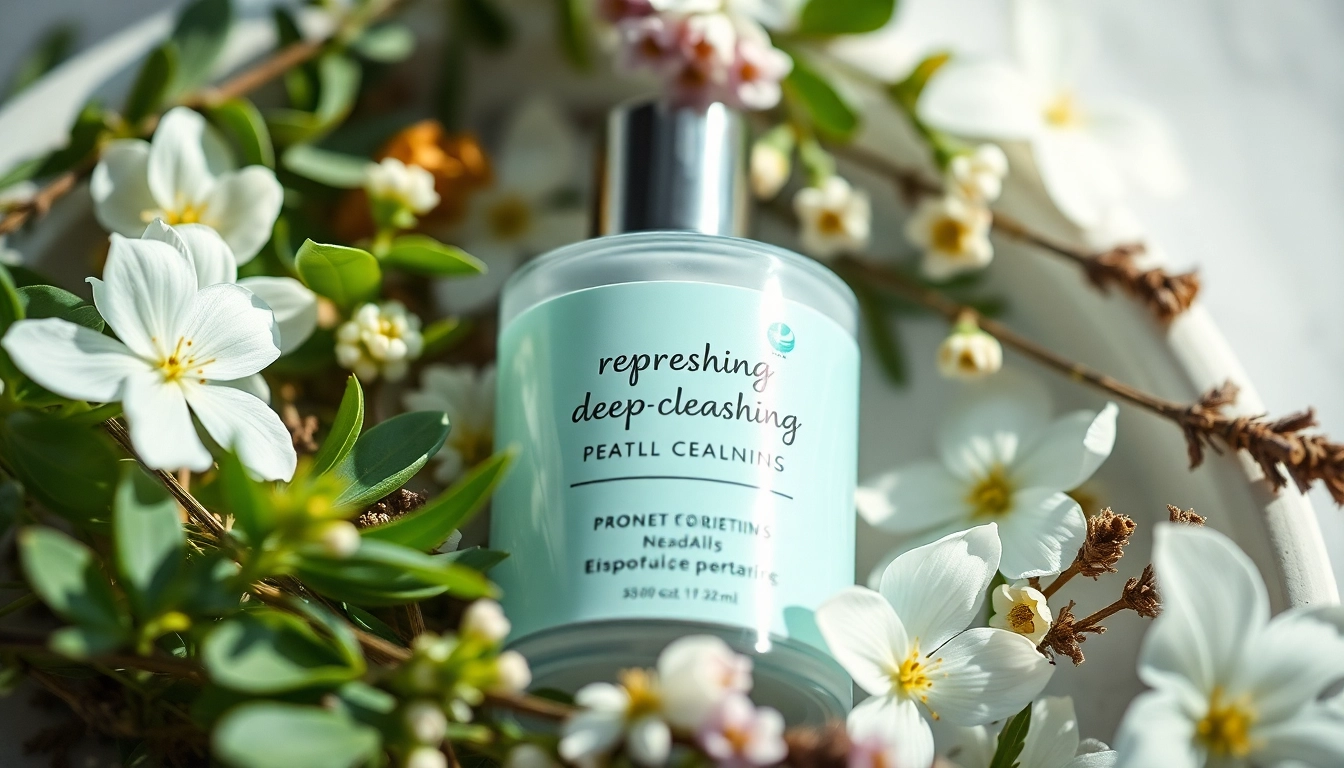Understanding the Importance of Deep Cleansing
In the pursuit of flawless skin, the significance of deep cleansing cannot be overstated. It goes beyond the superficial removal of makeup and dirt; it encompasses a therapeutic ritual that caters to the very essence of skin health. For anyone aiming to rejuvenate their complexion, understanding the fundamentals of deep cleansing is the first step toward the radiant, clear skin we all desire.
What is Deep Cleansing?
Deep cleansing is a skincare practice that targets impurities lodged within the pores, makeup residue, and excess sebum. This process typically employs specialized products, tools, or techniques to thoroughly purify the skin, making it feel fresh and revitalized. While many believe a quick wash is sufficient, deep cleansing reaches deeper than traditional facial washes, addressing issues such as acne, enlarged pores, and dullness.
The Benefits of Deep Cleansing for Your Skin
Deep cleansing offers numerous benefits that extend beyond just aesthetic improvements. Some of the notable advantages include:
- Clearer Complexion: By removing dead skin cells, dirt, and excess oil, deep cleansing promotes a brighter and more even skin tone.
- Reduced Acne and Breakouts: Targeting impurities helps minimize the chances of clogged pores, reducing the occurrence of acne.
- Improved Absorption of Skincare Products: With a clean canvas, your skin can better absorb serums and moisturizers, maximizing their benefits.
- Hydration Retention: Clean skin allows for better moisture retention, keeping your skin hydrated and plump.
- Promotion of Healthy Cell Turnover: Regular deep cleansing encourages skin cell renewal, leading to a healthier overall appearance.
Common Misconceptions about Facial Cleansing
Many individuals harbor misconceptions about deep cleansing that can hinder their skincare routines. Here are a few myths debunked:
- Myth 1: All cleansers are the same.
Truth: Different formulations cater to diverse skin types and needs. - Myth 2: Deep cleansing is only for oily skin.
Truth: Everyone can benefit from thorough cleansing to combat impurities. - Myth 3: You should cleanse until your skin feels tight.
Truth: A tight feeling often signifies over-cleansing or using harsh products.
Choosing the Right Deep Cleansing Products
Selecting the appropriate products is crucial to a successful deep cleansing routine. With countless options available, navigating the skincare aisle can be overwhelming.
Ingredients to Look for in Deep Cleansers
Identifying effective ingredients is key to maximizing the benefits of your deep cleansing regimen. Some top contenders include:
- Salicylic Acid: Excellent for oily and acne-prone skin, it penetrates pores to dissolve debris.
- Glycolic Acid: An alpha-hydroxy acid (AHA) that exfoliates the skin’s surface and promotes cell turnover.
- Charcoal: Known for its absorptive properties, charcoal can draw out impurities and toxins.
- Clay: Bentonite or kaolin clay can absorb excess oil, making them excellent for deep cleansing.
- Tea Tree Oil: Renowned for its antibacterial properties, it helps target the bacteria linked to acne.
Top Deep Cleansing Brands to Consider
While there are innumerable products on the market, some brands have cemented their reputation for effective deep cleansing:
- CeraVe: Known for its gentle formulations that are rich in ceramides.
- Neutrogena: Offers a variety of cleansers catering to specific skin types.
- Paula’s Choice: High-quality products focusing on well-researched ingredients.
- The ordinary: Affordable yet effective options that focus on potent actives.
- Kiehl’s: Offers natural formulations that deliver results without harsh chemicals.
How to Test Products for Skin Compatibility
Performing a patch test before introducing new products is essential to avoid unwanted reactions. Follow these steps:
- Choose a small area on your inner forearm for the test.
- Apply a small amount of the product and cover it with a bandage.
- Wait for 24-48 hours and observe for any adverse reactions.
- If there’s no redness, itching, or swelling, the product is likely safe for use.
Deep Cleansing Techniques for Different Skin Types
The effectiveness of deep cleansing can vary based on your skin type. Identifying your skin’s unique needs is essential for creating a tailored routine.
Oily Skin: Best Practices for Deep Cleansing
For oily skin, a robust and thorough cleansing routine is vital. Here are some tips:
- Use Foaming Cleansers: Look for foaming cleansers containing salicylic acid to reduce excess oil.
- Incorporate Exfoliation: Utilizing exfoliating cleansers 2-3 times a week can help prevent clogged pores.
- Consider a Clay Mask: Implement a clay mask weekly to absorb excess oil and detoxify the skin.
Dry and Sensitive Skin: Gentle Cleansing Approaches
For those with dry or sensitive skin, the focus should be on gentle cleansing techniques that don’t strip natural oils:
- opt for Creamy Cleansers: These provide hydration while cleansing without excess drying.
- Implement Hydrating Toners: Alcohol-free toners can replenish moisture post-cleansing.
- Avoid Over-Cleansing: Limit deep cleansing to 1-2 times per week to avoid irritation.
Combination Skin: Tailoring Your Cleansing Routine
Combining multiple approaches can be beneficial for those with combination skin:
- Use a Micellar Water: Good for removing makeup and impurities without stripping moisture.
- Target Specific Areas: Use exfoliating products only on oily areas while opting for gentler cleansers on drier patches.
- Rotate Products: Experiment with different cleansers based on your skin’s day-to-day needs.
DIY Deep Cleansing Recipes for Home Use
For those who prefer a hands-on approach, creating your deep cleansing products at home can be rewarding and effective.
Easily Made Natural Deep Cleansers
Many natural ingredients have cleansing properties that can be easily found in your kitchen. Here are a few recipes:
- Honey and Sugar Scrub: Mix equal parts honey and granulated sugar for a natural exfoliating cleanser.
- Oatmeal Cleanser: Blend oats with water to create a soothing and moisturizing wash.
- Yogurt Mask: Use plain yogurt directly on your face for its natural lactic acid benefits.
Step-by-Step Guide to Home Cleansing Masks
Creating and using DIY cleansing masks can enhance your skincare routine. Here’s a simple guide:
- Choose your base (clay, yogurt, or honey).
- Add active ingredients (essential oils, herbs, or exfoliants).
- Apply evenly over the face, avoiding the eyes and mouth.
- Leave on for 10-20 minutes.
- Rinse thoroughly with warm water and follow with your regular skincare routine.
Tips for Safe and Effective DIY Deep Cleansing
While DIY methods can be beneficial, there are essential dos and don’ts:
- Do: Test ingredients for allergies before application.
- Don’t: Use ingredients known to cause irritation, like lemon juice on sensitive skin.
- Do: Maintain cleanliness in the preparation method to prevent contamination.
- Don’t: Overuse products; moderation is key.
Monitoring Your Skin’s Response to Deep Cleansing
Your skin’s feedback is crucial in shaping an effective cleansing routine. Being attentive can help you assess what is working and what adjustments need to be made.
Signs Your Deep Cleansing Routine is Working
Positive indicators that your cleansing routine is effective include:
- Improvement in skin texture and tone.
- Decreased frequency of breakouts.
- Fewer visible pores and blackheads.
- A general feeling of freshness and hydration post-cleansed.
How to Adjust Your Approach Based on Skin Reaction
Changes in skin condition can serve as signals for adjustment:
- If your skin feels dry, consider switching to milder products or reducing frequency.
- Increased breakouts may indicate a need to change your product or technique.
- Note any redness or irritation as signs that a product may not be working for your skin.
When to Seek Professional Help for Deep Cleansing
While many skin issues can be resolved at home, some situations warrant professional intervention:
- Persistent acne that does not respond to over-the-counter products.
- Severe irritation or allergic reactions to products.
- Skin conditions such as eczema or psoriasis that require specialized treatment.
In conclusion, deep cleansing is a vital aspect of maintaining healthy skin. By understanding the importance of this practice, choosing the right products, employing tailored techniques, and being mindful of your skin’s response, you can navigate your skincare journey effectively. Whether opting for commercial products or making your natural remedies, prioritizing deep cleansing will undoubtedly contribute to achieving radiant, clear skin.



